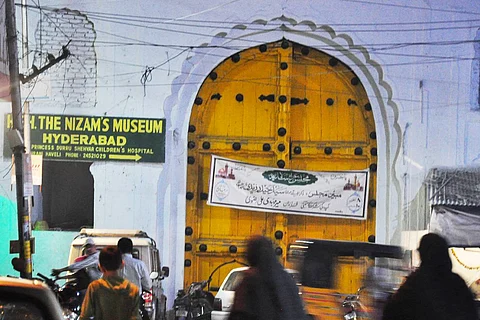

When interviewing an elderly Hyderabadi Kayasth for my upcoming book, I asked if, according to him, history had been tough on Hyderabad’s last Nizam, Mir Osman Ali Khan. After affirming the Nizam’s secular credentials and foresight in completing the city’s flood-proofing project with the Osman Sagar and Himayat Sagar reservoirs, he recited these Muzaffar Razmi lines, “Yeh jabr bhi dekha hai taareekh ki nazron ne / Lamhon ne khata ki thi, sadeeyon ne saza paayi.” (History has been a witness to this tragedy / That mistakes of moments have brought suffering to mankind for centuries.)
To this gentleman, all it took was a year of Nizam VII’s vacillating before an inevitable accession to the Indian Union to eclipse even the brighter spots of his 36-year reign. Similarly, in her latest book, Hyderabad, about India’s once richest princely state, Manreet Sodhi Someshwar likens the Nizam’s dilly-dallying to a “year-long mushaira with India that had transformed him into a depressing nautanki.”
This lengthy mushaira (an evening social gathering at which Urdu poetry is read) in which he didn’t rein in the Razakar militia that sought to uphold the Asaf Jahi dynasty’s Muslim rule in a Hindu-majority state, was an intense prelude to the bloodletting called Police Action. In the introduction to The Destruction of Hyderabad, AG Noorani described this episode as the final act of the tragedy that engulfed the Indian subcontinent upon independence. The other two acts were the partition that wrought havoc in north India and the 1947-48 Kashmir War.
The New York-based Manreet’s Lahore, which released last year, was the first offering in the HarperCollins-published The Partition Trilogy. With Hyderabad, she continues to blend fiction with the real-life political and human tragedy staged by statesmen and ordinary citizens 75 years ago.
The partition mayhem in Punjab, Bengal, and other parts of north India has been more documented, written about, and captured on celluloid. Yet, many other English memoirs like October Coup by Mohammed Hyder and Mir Laiq Ali’s The Tragedy of Hyderabad have chronicled Police Action. But when it comes to doing so with a fictional lens, it is mostly Telugu and Urdu titles that come to mind.
In Lahore, the narrative swung back and forth between the performers of statecraft in Delhi and ordinary folk who faced upheaval as a result of the former’s machinations. Similarly, Hyderabad has various characters from real-life factions steering the story of one of the best kept secrets in the annals of Indian history. These include The Hyderabad State Congress, Arya Samaj, the Nizam’s royal coterie, the then voluntary wing of the Majlis Ittehadul Muslimeen known as the Razakars, and the Communist party.
Besides Jawaharlal Nehru, Manreet’s protagonists are princess Niloufer, the wife of the Nizam’s philandering son Moazzam Jah, and the communist guerrilla Jaabili who is out to help overthrow a feudal system responsible for her oppression. The fourth protagonist Daniyal Khan is indicative of Manreet’s due diligence in undertaking research as a non-Deccani. This Makhdoom-Mohiuddin waxing reporter sympathetic to the Communist cause contains shades of two prominent Urdu journalists from that time. The first is reminiscent of the pro-Congress newspaper editor Shoaibullah Khan while the second is Akhtar Hassan, the editor of the progressive newspaper Payaam.
Be it this amalgamation, giving literary life to those who sacrificed themselves while overthrowing oppressive Telangana landlords (only to have them return courtesy of Indian military action), or incorporating local Deccani parlance, there is a lot to like about this second part of the trilogy.
Channeling a bit of Bapsi Sidhwa’s flair, the prose is just as delightful in Hyderabad as it was in Lahore. With the sentences peppered with advanced vocabulary, some may have to consult a dictionary. Luckily, that doesn’t detract from its readability. Plus, there is no doubting the excellent plot. That too, with a motley of personages such as communal ideologues like Qasim Razvi along with those of the Hindu Mahasabha/Arya Samaj, spies within King Kothi, communist revolutionaries, a reality-averse monarch, and the founding fathers of two new independent nation-states. However, the novel’s ending will come off as abrupt for the Deccan history buff.
The bloodletting in the present-day Marathwada and Hyderabad-Karnataka districts as well as the subsequent military campaign in Telangana feel maliciously glossed over. Readers have to do with three pithy summaries of these two landmark events that transpired in the territories that constituted Hyderabad state. Judging from the select bibliography at the end, which includes P Sundrayya’s Telangana People’s Struggle and Its Lessons and the aforementioned Noorani classic, Manreet definitely read about those occurrences. However, they deserved more than two chapters and a postlude.
With regard to encompassing the year-long intrigue before Police Action, the whole book is well-crafted and engaging. Though as a Deccani, I wouldn’t have minded an extra 50 pages centered around how the characters who lived beyond August 1948 fared during military action — not just in the Marathi and Kannada-speaking districts of the erstwhile princely state — but the rebellion-ridden Telangana portion too.
Moreover, those who view the Asaf Jahi rule as benign towards all its subjects will detest the Nizam’s portrayal as a miserly, indecisive, and impractical monarch, and not the farsighted statesman he was also known to be. His triumphs such as the founding of Osmania University and his pluralistic nature are alluded to in the book. However, Hyderabad takes place during a crucial juncture when the Nizam failed to take into account certain realities in his bid to keep Hyderabad independent. Being cognizant not just of his dominion’s landlocked geography, but the fact that he was at the helm of an exploitative feudal setup that was ultimately responsible for him being “the world’s richest man” would have spared his subjects of the bloodletting. Nonetheless, it is wonderful to see the saga surrounding Hyderabad’s testy circumstances around its accession to India at the center of some partition-centric historical fiction.